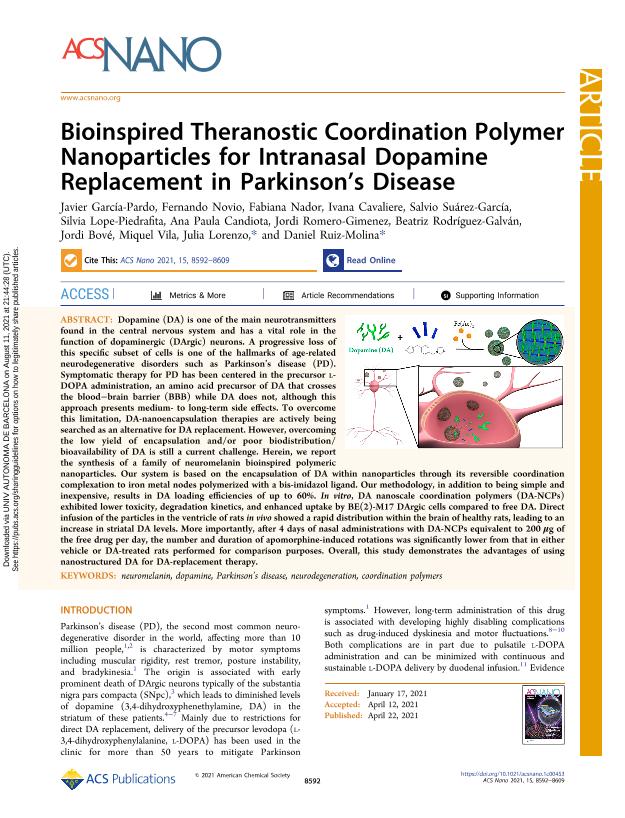Mostrar el registro sencillo del ítem
dc.contributor.author
García Pardo, Javier
dc.contributor.author
Novio, Fernando

dc.contributor.author
Nador, Fabiana Gabriela

dc.contributor.author
Cavaliere, Ivana
dc.contributor.author
Suárez García, Salvio
dc.contributor.author
Lope Piedrafita, Silvia
dc.contributor.author
Candiota, Ana Paula
dc.contributor.author
Romero Gimenez, Jordi
dc.contributor.author
Rodríguez Galván, Beatriz
dc.contributor.author
Bové, Jordi
dc.contributor.author
Vila, Miquel
dc.contributor.author
Lorenzo, Julia
dc.contributor.author
Ruiz Molina, Daniel

dc.date.available
2023-09-13T16:55:32Z
dc.date.issued
2021-05
dc.identifier.citation
García Pardo, Javier; Novio, Fernando; Nador, Fabiana Gabriela; Cavaliere, Ivana; Suárez García, Salvio; et al.; Bioinspired theranostic coordination polymer nanoparticles for intranasal dopamine replacement in parkinson's disease; American Chemical Society; ACS Nano; 15; 5; 5-2021; 8592-8609
dc.identifier.issn
1936-0851
dc.identifier.uri
http://hdl.handle.net/11336/211423
dc.description.abstract
Dopamine (DA) is one of the main neurotransmitters found in the central nervous system and has a vital role in the function of dopaminergic (DArgic) neurons. A progressive loss of this specific subset of cells is one of the hallmarks of age-related neurodegenerative disorders such as Parkinson's disease (PD). Symptomatic therapy for PD has been centered in the precursor l-DOPA administration, an amino acid precursor of DA that crosses the blood-brain barrier (BBB) while DA does not, although this approach presents medium- to long-term side effects. To overcome this limitation, DA-nanoencapsulation therapies are actively being searched as an alternative for DA replacement. However, overcoming the low yield of encapsulation and/or poor biodistribution/bioavailability of DA is still a current challenge. Herein, we report the synthesis of a family of neuromelanin bioinspired polymeric nanoparticles. Our system is based on the encapsulation of DA within nanoparticles through its reversible coordination complexation to iron metal nodes polymerized with a bis-imidazol ligand. Our methodology, in addition to being simple and inexpensive, results in DA loading efficiencies of up to 60%. In vitro, DA nanoscale coordination polymers (DA-NCPs) exhibited lower toxicity, degradation kinetics, and enhanced uptake by BE(2)-M17 DArgic cells compared to free DA. Direct infusion of the particles in the ventricle of rats in vivo showed a rapid distribution within the brain of healthy rats, leading to an increase in striatal DA levels. More importantly, after 4 days of nasal administrations with DA-NCPs equivalent to 200 μg of the free drug per day, the number and duration of apomorphine-induced rotations was significantly lower from that in either vehicle or DA-treated rats performed for comparison purposes. Overall, this study demonstrates the advantages of using nanostructured DA for DA-replacement therapy.
dc.format
application/pdf
dc.language.iso
eng
dc.publisher
American Chemical Society

dc.rights
info:eu-repo/semantics/openAccess
dc.rights.uri
https://creativecommons.org/licenses/by/2.5/ar/
dc.subject
COORDINATION POLYMERS
dc.subject
DOPAMINE
dc.subject
NEURODEGENERATION
dc.subject
NEUROMELANIN
dc.subject
PARKINSON'S DISEASE
dc.subject.classification
Métodos de Investigación en Bioquímica

dc.subject.classification
Ciencias Biológicas

dc.subject.classification
CIENCIAS NATURALES Y EXACTAS

dc.title
Bioinspired theranostic coordination polymer nanoparticles for intranasal dopamine replacement in parkinson's disease
dc.type
info:eu-repo/semantics/article
dc.type
info:ar-repo/semantics/artículo
dc.type
info:eu-repo/semantics/publishedVersion
dc.date.updated
2023-09-13T11:48:05Z
dc.journal.volume
15
dc.journal.number
5
dc.journal.pagination
8592-8609
dc.journal.pais
Estados Unidos

dc.description.fil
Fil: García Pardo, Javier. Universitat Autònoma de Barcelona; España
dc.description.fil
Fil: Novio, Fernando. Universitat Autònoma de Barcelona; España
dc.description.fil
Fil: Nador, Fabiana Gabriela. Consejo Nacional de Investigaciones Científicas y Técnicas. Centro Científico Tecnológico Conicet - Bahía Blanca. Instituto de Química del Sur. Universidad Nacional del Sur. Departamento de Química. Instituto de Química del Sur; Argentina
dc.description.fil
Fil: Cavaliere, Ivana. Consejo Superior de Investigaciones Científicas; España
dc.description.fil
Fil: Suárez García, Salvio. Universitat Autònoma de Barcelona; España
dc.description.fil
Fil: Lope Piedrafita, Silvia. Universitat Autònoma de Barcelona; España
dc.description.fil
Fil: Candiota, Ana Paula. Universitat Autònoma de Barcelona; España
dc.description.fil
Fil: Romero Gimenez, Jordi. Consejo Superior de Investigaciones Científicas; España
dc.description.fil
Fil: Rodríguez Galván, Beatriz. Universitat Autònoma de Barcelona; España
dc.description.fil
Fil: Bové, Jordi. Consejo Superior de Investigaciones Científicas; España
dc.description.fil
Fil: Vila, Miquel. Universitat Autònoma de Barcelona; España
dc.description.fil
Fil: Lorenzo, Julia. Universitat Autònoma de Barcelona; España
dc.description.fil
Fil: Ruiz Molina, Daniel. No especifíca;
dc.journal.title
ACS Nano

dc.relation.alternativeid
info:eu-repo/semantics/altIdentifier/url/https://pubs.acs.org/doi/10.1021/acsnano.1c00453
dc.relation.alternativeid
info:eu-repo/semantics/altIdentifier/doi/http://dx.doi.org/10.1021/acsnano.1c00453
Archivos asociados
